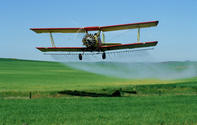
Leaf and Stem Diseases in Small Grain
Rust is a fungal disease in small grain affects both yield and crop quality, with the severity of damage depending on environmental conditions and the plant or variety’s susceptibility to the specific strain. Stem rust is regarded as generally more destructive than leaf and stripe rust, while crown rust only affects oats.
Outbreaks can be prevented by planting resistant varieties. Fungicides are also generally applied during the seven leaf and flag leaf stages to keep the disease in check, since strains may over time overcome breed resistance. With some strains, problems can be alleviated by planting small-grains earlier in the season. Powdery Mildew is another fungal disease that affects the leaves and stems of small grains.
Similar to rust, it produces spores that survive on host debris or volunteer crops during non-crop seasons. The disease usually occurs in densely planted fields that are over-fertilised. Foliar applications of fungicides are the primary method of control. Septoria predominantly occurs in densely planted, heavily fertilised wheat. Various strains of this fungal disease exist, with the septoria leaf blotch mainly occurring when the growing season is wet and windy.
In the past, farmers might have burnt their lands to get rid of septoria, but this practice is frowned upon today as it destroys both beneficial and non-beneficial organisms. The better options are to plant resistant varieties and use crop rotation to break the disease cycle. Various foliar fungicides also exist to help control the disease.
Ear and Grain Diseases
Bunts and smuts are fungal diseases in small grain that infect small grain cereals and several species of grass. The most important of these are loose smut and covered smut, which infects germinating seeds and then forms a systemic infection, after which the disease penetrates the head tissue and converts it to masses of spores.
Seed treatment is the most effective way of preventing this small grain disease, so don’t take chances with uncertified or non-treated seed. Karnal bunt was first identified in South Africa in December 2000 in the Douglas irrigation area. It is regarded as a quarantine disease, so suspected outbreaks have to be reported to the Department of Agriculture.
Various measures are implemented to prevent the spreading of the disease out of the affected area, including the washing of farm machines after they have worked on affected land. Infected kernels appear blackened, eroded and emit a foul “fishy smell”, which is transferred to the milled flour.
The disease stunts the growth of plants and results in premature ripening and dying. Microscopic examination of the seed is needed to correctly identify the disease, since it does not always affect the whole ear. While some fungicides may help to reduce disease incidents, nothing is yet registered to prevent infection.
Stem Base and Root Diseases in Small Grain
Take-all affects the roots, crown and basal stem of grains, particularly wheat. This fungal disease predominantly occurs in intensive production systems, where the soil pH is alkaline, soils are deficient in nitrogen and or manganese and poorly drained. The disease is also more prominent during wet years and on irrigated fields.
Crop rotation is the best way to break the disease cycle, while ensuring wheat plants have sufficient nutrients to promote good healthy roots, will also help. Eyespot, Strawbreaker primarily affect wheat in the winter rainfall area. The disease is more prevalent in early sown, over fertilised crops and in areas with poor drainage.
The disease weakens individual lateral branches, known as tillers, and leads to the premature ripening of ears, which in turn will make it difficult to harvest the wheat. It is managed through crop rotation and the use of fungicides.